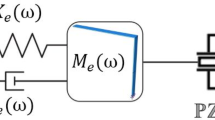Abstract
In this paper two methods for damage localization, the IDDM (Interpolation Damage Detecting Method), and the Modal Shape Curvature Method (MSCM) are applied to the same experimental case of a cantilever aluminum beam for which several different damage scenarios have been artificially reproduced in laboratory. IDDM is a new method recently proposed in literature which is on the definition of a damage-sensitive feature in terms of the accuracy of a spline function interpolating the Operational Displacement Shapes of the structure. This paper will present a comparison between the two methods on experimental data from a laboratory bench structure. Results show that, due to the small changes of the damage features induced by damage, both methods require a high-quality data set to provide a reliable damage localization even if the number of false alarms is slightly lower if the IDDM is applied.












Similar content being viewed by others
References
Carden EP (2004) Vibration based condition monitoring: a review. Struct Heal Monit 3:355–377
Farrar C, Jauregui D (1999) Comparative study of damage identification algorithms applied to a bridge: I. Experiment. Smart Mater Struct 7:704
Salawu OS (1997) Detection of structural damage through changes in frequency: a review. Eng Struct 19:718–723
Patil DP, Maiti SK (2003) Detection of multiple cracks using frequency measurements. Eng Fract Mech 70:1553–1572
Yang Z, Wang L (2009) Structural damage detection by changes in natural frequencies. J Intell Mater Syst Struct 21:309–319
Pandey A, Biswas M, Samman M (1991) Damage detection from changes in curvature mode shapes. J Sound Vib 145:321–332
Ratcliffe C (2000) A frequency and curvature based experimental method for locating damage in structures. J Vib Acoust 122:324–329
Hamey CS (2004) Experimental damage identification of carbon/epoxy composite beams using curvature mode shapes. Struct Heal Monit 3:333–353
Yoon M-K, Heider D, Gillespie JW, Ratcliffe CP, Crane RM (2009) Local damage detection with the global fitting method using mode shape data in notched beams. J Nondestruct Eval 28:63–74
Li G, Hao K, Lu Y, Chen S (1999) A flexibility approach for damage identification of cantilever-type structures with bending and shear deformation. Comput Struct 73:565
Zhou Z, Wegner L, Sparling B (2007) Vibration-based detection of small-scale damage on a bridge deck. J Struct Eng 133:1257–1267
Li J, Wu B, Zeng QC, Lim CW (2010) A generalized flexibility matrix based approach for structural damage detection. J Sound Vib 329:4583–4587
Shi Z, Law S, Zhang L (1998) Structural damage localization from modal strain energy change. J Sound Vib 218:825–844
Kim J-T, Stubbs N (2002) Improved damage identification method based on modal information. J Sound Vib 252:223–238
Choi S, Park S, Park N-H, Stubbs N (2006) Improved fault quantification for a plate structure. J Sound Vib 297:865–879
Sampaio R, Maia N, Silva J (1999) Damage detection using the frequency-response-function curvature method. J Sound Vib 226:1029–1042
Ratcliffe CP (1997) Damage detection using a modified laplacian operator on mode shape data. J Sound Vib 204:505–517
Ramesh Babu T, Sekhar AS (2008) Detection of two cracks in a rotor-bearing system using amplitude deviation curve. J Sound Vib 314:457–464
Zhang Y, Lie ST, Xiang Z (2013) Damage detection method based on operating deflection shape curvature extracted from dynamic response of a passing vehicle. Mech Syst Signal Process 35:238–254
Pai PF, Jin S (2000) Locating structural damage by detecting boundary effects. J Sound Vib 231:1079–1110
Limongelli MP (2010) Frequency response function interpolation for damage detection under changing environment. Mech Syst Signal Process 24:2898–2913
Limongelli MP (2011) The interpolation damage detection method for frames under seismic excitation. J Sound Vib 330:5474–5489
Limongelli MP (2014) Seismic health monitoring of an instrumented multistorey building using the Interpolation Method. Earthq Eng Struct Dyn 43:1581
Limongelli MP (2003) Optimal location of sensors for reconstruction of seismic responses through spline function interpolation. Earthq Eng Struct Dyn 32:1055–1074
Roy K, Ray-Chaudhuri S (2013) Fundamental mode shape and its derivatives in structural damage localization. J Sound Vib 332:5584–5593
Ewins DJ (2010) Modal testing: theory, practice and application (Mechanical Engineering Research Studies: Engineering Dynamics Series). Wiley, New York
Maia NMM, Silva JMM e (1997) Theoretical and experimental modal analysis (Mechanical Engineering Research Studies. Engineering Control Series, 9). p 488
Alvandi A, Cremona C (2006) Assessment of vibration-based damage identification techniques. J Sound Vib 292:179–202
Fan W, Qiao P (2010) Vibration-based damage identification methods: a review and comparative study. Struct Heal Monit 10:83–111
Sazonov E, Klinkhachorn P (2005) Optimal spatial sampling interval for damage detection by curvature or strain energy mode shapes. J Sound Vib 285:783–801
Author information
Authors and Affiliations
Corresponding author
Rights and permissions
About this article
Cite this article
Busca, G., Limongelli, M.P. An experimental evaluation of the reliability of a damage localization algorithm based on FRF interpolation. J Civil Struct Health Monit 5, 427–439 (2015). https://doi.org/10.1007/s13349-015-0126-7
Received:
Revised:
Accepted:
Published:
Issue Date:
DOI: https://doi.org/10.1007/s13349-015-0126-7




